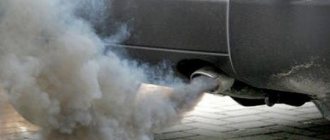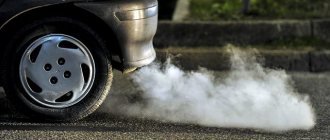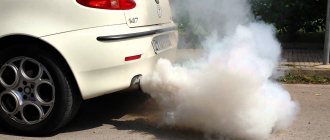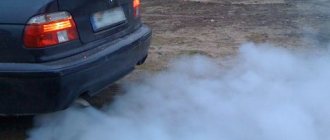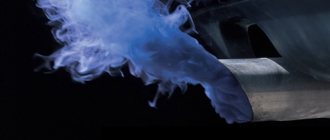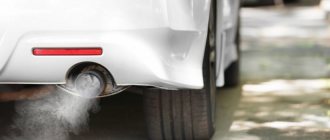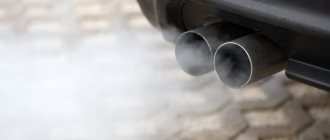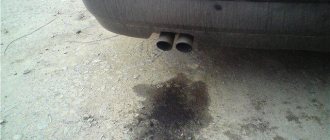Diesel engines are significantly different from gasoline engines. But the problems with them are almost the same as with gasoline units. After reading car forums, you can see many different topics where certain problems are discussed. But you can especially often see topics where car enthusiasts complain that diesel engines periodically emit black smoke from the exhaust. Let's figure out what the problem is and why this phenomenon occurs. Let's also see how this problem can be solved.
Making a diagnosis based on exhaust colors
Diesel engines, as well as gasoline engines, can have exhausts of various colors. More often it is white, bluish, gray and black smoke.
Let's start with white. Often white is the name given to smoke with a bluish tint. This happens when the turbine is destroyed and the lubricant gets directly into the intake tract. In such a situation, bluish smoke pours out of the chimney. But an inexperienced car enthusiast will easily mistake it for white smoke. And if you smell it, then it’s immediately clear and understandable what the reason for its appearance is.
Many people have burned vegetable oil or butter in a frying pan at least once in the kitchen. The smell is about the same. This smoke can also be confused with steam, which is more often observed in the winter months from the exhaust of not only diesel cars. It's all because of the water that appears as a result of combustion.
Later, after the engine has warmed up, the steam will not be noticeable, although it will not go away. This can be easily checked. You just need to place your palms near the exhaust. The palm will be slightly damp. This steam causes significant inconvenience when tuning the engine, especially in winter. For high-quality settings, you have to warm up the unit for a long time. And in cold weather the adjustment may not be possible at all.
Common Rail and Pump Duse systems smoke what to do
Use the Systempflege Diesel additive, which contains chemical components that provide highly effective cleaning of Common Rail and Pump-Duse fuel systems, as well as reliable protection of fuel lines and other parts of fuel equipment from premature wear due to the accumulation of solid and oily contaminants.
Possessing anti-corrosion properties, the product helps to extend engine life due to its ability to bind and eliminate water inclusions in diesel fuel, while simultaneously increasing its lubricating characteristics. Recommended for use in diesel engines of KIA cars and models of other brands with Common-Rail and Pump-Duse fuel systems.
Systempflege Diesel additive every 2-3 thousand km. mileage is poured into the fuel tank at the rate of 250 ml per 70 liters. diesel fuel
2. Cleaning of Common-Rail and Pump-Duse fuel systems can also be done using Pro-Line Ansaug System Reiniger Diesel flushing, described above.
For all injection systems
Diesel additive Diesel Russ-Stop fuel for reducing the smoke level of diesel engines has pronounced non-stick and anti-corrosion properties, providing reliable protection of injector needles and preventing the formation of soot and rust on all elements of the fuel supply system.
At the same time, the Diesel Russ-Stop additive increases the calorific value of the fuel, making the soot combustion process more active, due to which the product is indicated for use to prevent smoke formation. It is especially recommended for use in used engines of cars of previous generations.
For all stationary diesel engines and vehicle engines, including cars and trucks (except for those equipped with a particulate filter), agricultural and road-building special equipment. The additive is added to the fuel tank at the rate of 150 ml. for every 50 l. diesel fuel
Repair
If you find a crack in the cylinder head, then we can only recommend replacing the head. However, prices... Therefore, many car enthusiasts do not disdain contract details. These are used parts from Europe.
Cracked cylinder heads can be repaired, but we will not recommend this technology, because during such repairs a hole is drilled that will fit into the crack, and then a copper rod is pressed into the hole. There will be no blow-by, but one of the cooling valves will be blocked halfway. Such a head will have a significantly reduced resource.
Anti-smoke additives - a panacea or a waste?
Various auto chemical brands offer special additives to reduce oil consumption. They form a film on the rubbing parts of the engine that protects them from wear and fills existing microcracks. The use of additives replaces the decoking of piston rings, cleaning them from dirt. Manufacturers promise all this, but is it really so?
On auto forums you can find conflicting opinions about anti-smoke additives. Some auto mechanics note that the use of such products makes it difficult to overhaul the engine. The engine parts are covered with an oil layer, which is very difficult to completely wash off. Individual parts that could simply be cleaned have to be replaced, which means repairs are more expensive.
The additive only slightly extends the life of the engine before repair, but does not guarantee its trouble-free operation.
Blue smokes
For those with smoke pouring out of the exhaust pipe, diesel made them worry at the sight of blue smoke.
Blue, and on some engines it can be gray, on a working engine it is often caused by late injection. This problem has been mentioned more than once; many car enthusiasts have managed to discuss this topic up and down.
Experts say blue smoke is not scary. In most cases, the problem of late injection is associated with the natural process of wear of the fuel injection pump, naturally, if no one touched the pump.
Causes of Blue Smoke
The high pressure fuel pump in our conditions works as follows. The set of parts in this assembly constantly rotates, works, and rubs. And lubrication is provided by the pumped diesel engine. As long as the diesel engine is moderately oily, the pump can operate in this mode for a very long time. But when cold weather sets in, winter diesel fuel is poured into diesel fuel tanks. Everything about it is excellent, but there are no lubricating fractions at all. Well, or almost absent. All its fat content, along with various paraffins, was removed at the oil refinery.
So, when winter comes, most diesel injection pumps operate without lubrication and are subject to severe wear. Because of this completely natural, but already too rapid and increased wear, the injection advance is reduced. Diesel fuel stops heating and the cylinder stops working normally. The engine jerks and shakes. Fuel that does not have time to burn ends up turning into blue smoke. Some engines produce black smoke from the exhaust. If the engine is warmed up, then it will stop smoking, or at least the amount of exhaust will decrease. In this case, the fuel has time to warm up and ignite.
If the power unit has low compression characteristics, then the temperature in the combustion chambers is lower than necessary. And the fuel will not ignite. If the unit is equipped with a pair of cylinders with good compression, the cylinder with less compression will not work.
This picture often happens in parking lots. The cars are trying to start, and the entire area is filled with blue smoke. But sometimes diesel produces black smoke from the exhaust pipe. After warming up, the smoke will disappear. After all, the temperature in the engine is rising, and the temperature increase even in worn-out cylinders will be enough for ignition.
Checking the functionality of the injectors
If one of them is clogged, the motor will “triple”: it’s not difficult to figure out the culprit. You need to start the engine and turn off each injector one by one. A change in the sound of a running motor indicates the normal condition of the part. If there is no response from the power unit, we can assume that the problematic spare part has been found. But if the injector overflows, then finding it will require a more complex procedure. Before testing, prepare a 20 ml disposable syringe and a transparent IV tube.
Further:
- remove the plunger from the syringe;
- start the engine and connect the syringe to the “return” of the nozzle, i.e. insert the tube into the neck of the medical instrument;
- hold the syringe for a couple of minutes until it fills with diesel fuel (if it does);
- repeat the operation for all injectors.
An empty syringe or 4-5 ml of diesel fuel in it indicates the serviceability of the part. The presence of 10-15 ml inside is a sign of its partial functionality (repair and cleaning are possible). A volume of 20 ml of fuel in the syringe indicates the need to replace the injector. The exact volume of diesel fuel that it must dump back must be indicated in the vehicle instructions.
Schematic representation of injectors
A case from one's life
Mechanics tell one story on this topic. The cylinder head gasket on the unit was replaced. After the engine was assembled, we discovered strong shaking at idle. After a couple of kilometers these vibrations stopped, and after a couple of minutes of idling the shaking reappeared. Mechanics analyzed this situation and found out that the new gasket was slightly thicker. Until the diesel engine warmed up to operating temperature, it did not work smoothly.
So, the main cause of blue smoke is late fuel injection and low compression performance. Many modern engines have a device that performs injection a little earlier. Cars work harder, but the fuel in the cylinders heats up and burns without smoke, that is, at all. Then the unit heats up, the coolant heats up the actuators, and they return the injection advance piston to its rightful place. The motor runs smoother and more pleasant.
Old school
It is worth making a digression and mentioning “old” school engines, whether swirl chamber or direct injection, on which environmental limiters in the form of a particulate filter, catalyst or USR system are not available from the factory or have been cut out/removed by the owners. If gray smoke with a bluish tint in the first minutes after starting the engine in cold weather does not appear in conjunction with poor starting, loss of dynamics, harsh and uneven operation, the owner should not worry.
Slightly decreased compression, deviations in cyclic flow due to wear of injectors, imperfect operation of individual sensors are a natural consequence of long years of operation and high mileage. The owner just needs to make sure that the thermostat, glow plugs, USR and idle speed increase system are in good condition, which are extremely important for quick engine warm-up and smooth operation after a cold start.
Why does black smoke come out of a diesel exhaust pipe?
A larger volume of supplied fuel is usually a signal of either incorrect adjustment of the fuel injection pump, wear of the injectors, or wear of the speed controller in the pump.
Any fuel pump is equipped with a special adjusting screw. It is used to adjust the volume of supplied fuel. With this screw you can only roughly adjust the volume. If this screw is tightened, then the volumes increase. And where there is an increase in volumes, there is also an increase in idle speed. But the speed can be significantly reduced. Then you can increase the power. But black smoke from the exhaust pipe will continue to drive diesel. If the adjusting screw on the fuel injection pump is screwed in even more than it should be, the unit will practically stop reducing speed.
How to check the injection pump
Incorrect operation of this device may be accompanied not only by black smoke, but associated symptoms include:
- increased fuel consumption;
- unstable idling;
- problems when starting a diesel engine;
- constant overheating;
- drop in power, sluggish acceleration;
- extraneous noise during operation of the power unit.
The best option for checking the performance of the fuel injection pump is to use a stand in an auto repair center. In a garage, you can only partially check the pump:
- To check the plunger pairs of the device, remove the timing belt and slowly rotate the pulley. If you feel variable force, there is no water in the parts. If it is present, the shaft will not rotate, and the pump may jam at startup.
- The pressure in the pump is checked using the RB-4802 tester or another similar device. It is screwed in instead of the fuel pump pipe. The correct readings are 300 kg/sq.m. see, if this is not the case, replace the plunger pair.
- In an electronically controlled motor, the speed sensor may break. In this case, diesel fuel does not enter the cylinders. The sensor is checked with an ohmmeter: infinite resistance indicates a break.
- Another reason for poor fuel injection pump performance is fuel leakage. To check the assumption, start the engine and shake the axis of the device lever. If you see diesel fuel leaking, replace the rubber seal in the problem area.
The saddest thing
One of the saddest breakdowns that beset diesel owners is the inevitable wear and tear of the fuel pump. As already mentioned, the guts inside the pump operate without lubrication. While diesel still lubricates something in summer, in winter it doesn’t. And domestic fuel is generally of low quality. This is where the insides of the pump wear out.
When the gas pedal is pressed very sharply, for example, in order to quickly move off, the injection pump lever is switched to increase the volume of fuel supply. This lever will rest on the support. And the position of this very support has already been adjusted by the regulator. Therefore, it will not be possible to increase the volume too sharply. So, by pressing the pedal, the driver only wants to give a larger volume of fuel. And it’s not at all a fact that this will lead to an increase in turnover. This directly depends on how worn the speed controller is. If it is in normal condition, then the car will start with gray smoke. If the wear is large, then the diesel will spit out black smoke from the exhaust pipe in a large cloud.
About lack of air
Also, dark gases from the pipe can sometimes be caused by a lack of air. But in this case, the exhaust will not be black, but rather gray or dark gray. At the same time, a decrease in power is observed.
This can be caused by a clogged air supply filter. This is by no means a rare case, and it happens to everyone from time to time. It has been proven not 10 or 100 times by bitter experience that only 15 minutes in a traffic jam in front of a KamAZ truck with black smoke coming out of the exhaust pipe is enough. The diesel is burning, and the new filter of the one standing behind can now be thrown into a landfill. But this happens if KamAZ’s fuel system is incorrectly adjusted, although no one has it adjusted.
Also, a lack of air can be observed due to incorrect operation of the EGR and throttle valve, incorrect clearances in the timing valves. Also among the reasons may be incorrectly set gas distribution marks, turbine malfunctions.
When the car is equipped with a turbine and you see black smoke from the exhaust pipe of a diesel turbo, then it is worth checking the boost. Most likely, that's the problem. It is also worth looking for cracks in the fuel or air system pipes.
One of the car owners poured fuel system cleaner into the car. After driving for a while, at high speeds when driving uphill, the car began to puff out black smoke. But after puffing a little, the smoke disappeared and has not appeared since then. At the same time, he checked all the above reasons. He believes the additive helped. The car didn't smoke anymore. So, perhaps the cause of the smoke in this case may simply be soot from the fuel system, especially if the diesel engine is equipped with a converter. Sometimes the filter needs to be cleaned from time to time.
Consequences of soot formation
Once black exhaust ceased to be a characteristic of this type of engine, but began to indicate a malfunction, the consequences became impossible to ignore.
Failure to eliminate the causes in a timely manner will lead to higher costs for inevitable repairs:
- the particulate filter will overload and fail;
- soot will clog the exhaust system, turbine and EGR valve;
- carbon deposits will penetrate into the oil sump and damage the lubrication system;
- in addition to soot, the oil will be diluted with liquid fractions of unburned fuel, which will deprive it of its programmed properties and will lead to accelerated wear of the cylinder-piston group and the crankshaft with bearings and connecting rods;
- the thermal regime of the motor will be disrupted, overheating will lead to breakdowns and deformations of parts;
- the gas distribution mechanism, primarily the valves, will become unusable;
- the engine will reduce power and increase fuel consumption.
The possibility of self-repair is very limited; the simplest diesel engines are no longer produced, and in modern ones you can only change the fuel and air filter.
Everything else will require contacting specialized enterprises that service diesel engines.
Another reason for black smoke from a diesel exhaust pipe
One of the owners of a diesel car suddenly began to smoke. During the autopsy, nothing intelligible could be found. But after reading all kinds of forums and talking with other diesel owners, it turned out that the problem was in the ignition.
After opening it again, a control valve was found on the ignition unit. He was advised to hit the adjusting bolt. After that the car stopped smoking. It turned out that it was the ignition angle solenoid valve.
When the ignition is turned on, a working sensor crackles. What to do if black smoke appears from the exhaust pipe (diesel)? No matter what ignition it appears, the sensor should be removed. If the engine has stopped smoking and the car is running smoothly, then it’s time to change this element.
Air filter dirty
This element of the fuel system belongs to the category of consumables. Therefore, it must be changed on time in accordance with the instructions for the machine. However, if it is constantly used in difficult conditions, for example, with heavy dust, then the intervals between replacing the air filter should be reduced. It is especially important to prevent moisture from getting on it. If this does happen, the filter must be thoroughly dried or a new one installed.
Standard rectangular air filter
The frequency of replacing the air element is from 15 to 30 thousand km. It is recommended to change the filter along with the oil, i.e. after about 10 thousand km. The replacement process can be entrusted to specialists at a service station or you can do everything yourself: it is not difficult. Each machine attaches the filter differently: these can be bolts, screws, or plastic latches. But in most cases, the algorithm of actions is as follows:
- Place the car on a level surface, activate the handbrake, turn off the engine;
- open the hood, find the location of the filter and remove its cover;
- pull out the air element carefully so that accumulated dust and debris do not get inside the engine;
- plug the inlet pipe with a clean rag;
- using a compressor, or better yet, a vacuum cleaner, remove dust from the seat;
- remove the rags from the pipe and install a new filter;
- return the cover to its place and secure it.
If it is not possible to purchase a new product, you can clean the old one, but this is only a temporary measure: you will still have to buy a filter.
Black smoke and cold start
A study of the forums showed that many people complain about smoke when starting a diesel engine when cold. Some people say that this is a fuel injection pump, but more experienced car enthusiasts say that this is not so.
It is believed that this phenomenon is quite normal. Usually it is short-lived. This can be explained by the fact that during a cold start, an over-rich mixture is supplied to the cylinders. Hence the black smoke from the exhaust pipe. Diesel often does this when cold. Therefore, there is no need to panic about this.
The situation with the Kia Sorento
Let's give a specific example. One of the owners of this car produces thick, black smoke when pressing the accelerator pedal. When moving, the car is very reluctant to gain momentum.
A scan was carried out for possible errors in the electronic system, but there were no errors. Analysis of the operating parameters also did not give the desired result. At first glance, there is simply no defect. The balance of the injectors is in normal condition, no serious deviations were noticed, the turbine produces a normal level of pressure, but the Kia Sorento diesel still produced black smoke from the exhaust pipe. When measuring the readings, we thought about the USR. This is a valve that regulates exhaust gases.
After examining it, they discovered serious soot deposits behind the throttle valve. After removing the exhaust gas pipe, soot and oil were also found in the intake tract. In the end everything was removed and cleaned. But a more detailed examination of the valve itself revealed damage to its seat. As a result, the valve was replaced.
As a result, there is no smoke, and the car drives noticeably better.

